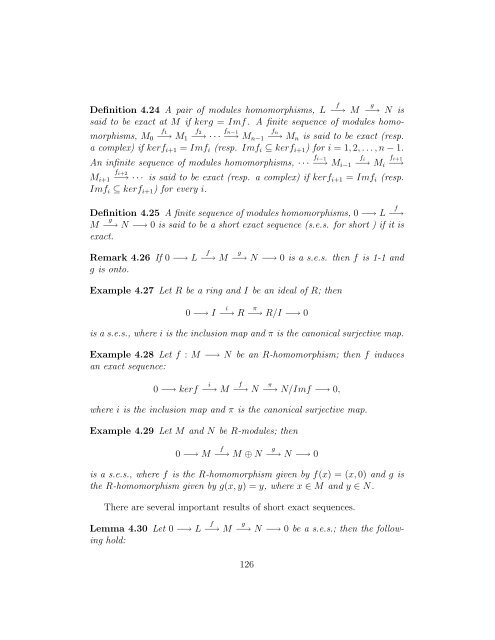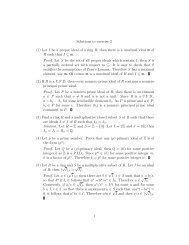Topics in algebra Chapter IV: Commutative rings and modules I - 1
Topics in algebra Chapter IV: Commutative rings and modules I - 1
Topics in algebra Chapter IV: Commutative rings and modules I - 1
Create successful ePaper yourself
Turn your PDF publications into a flip-book with our unique Google optimized e-Paper software.
Def<strong>in</strong>ition 4.24 A pair of <strong>modules</strong> homomorphisms, L f<br />
−→ M g<br />
−→ N is<br />
said to be exact at M if kerg = Imf. A f<strong>in</strong>ite sequence of <strong>modules</strong> homo-<br />
morphisms, M0<br />
f1<br />
−→ M1<br />
f2<br />
−→ · · · fn−1<br />
−→ Mn−1<br />
fn<br />
−→ Mn is said to be exact (resp.<br />
a complex) if kerfi+1 = Imfi (resp. Imfi ⊆ kerfi+1) for i = 1, 2, . . . , n − 1.<br />
An <strong>in</strong>f<strong>in</strong>ite sequence of <strong>modules</strong> homomorphisms, · · · fi−1<br />
−→ Mi−1<br />
fi<br />
−→ Mi<br />
fi+1<br />
−→<br />
Mi+1<br />
fi+2<br />
−→ · · · is said to be exact (resp. a complex) if kerfi+1 = Imfi (resp.<br />
Imfi ⊆ kerfi+1) for every i.<br />
Def<strong>in</strong>ition 4.25 A f<strong>in</strong>ite sequence of <strong>modules</strong> homomorphisms, 0 −→ L f<br />
−→<br />
M g<br />
−→ N −→ 0 is said to be a short exact sequence (s.e.s. for short ) if it is<br />
exact.<br />
Remark 4.26 If 0 −→ L f<br />
−→ M g<br />
−→ N −→ 0 is a s.e.s. then f is 1-1 <strong>and</strong><br />
g is onto.<br />
Example 4.27 Let R be a r<strong>in</strong>g <strong>and</strong> I be an ideal of R; then<br />
0 −→ I<br />
i<br />
−→ R π<br />
−→ R/I −→ 0<br />
is a s.e.s., where i is the <strong>in</strong>clusion map <strong>and</strong> π is the canonical surjective map.<br />
Example 4.28 Let f : M −→ N be an R-homomorphism; then f <strong>in</strong>duces<br />
an exact sequence:<br />
0 −→ kerf<br />
i<br />
−→ M f<br />
−→ N π<br />
−→ N/Imf −→ 0,<br />
where i is the <strong>in</strong>clusion map <strong>and</strong> π is the canonical surjective map.<br />
Example 4.29 Let M <strong>and</strong> N be R-<strong>modules</strong>; then<br />
0 −→ M f<br />
−→ M ⊕ N g<br />
−→ N −→ 0<br />
is a s.e.s., where f is the R-homomorphism given by f(x) = (x, 0) <strong>and</strong> g is<br />
the R-homomorphism given by g(x, y) = y, where x ∈ M <strong>and</strong> y ∈ N.<br />
There are several important results of short exact sequences.<br />
Lemma 4.30 Let 0 −→ L f<br />
−→ M g<br />
−→ N −→ 0 be a s.e.s.; then the follow<strong>in</strong>g<br />
hold:<br />
126



